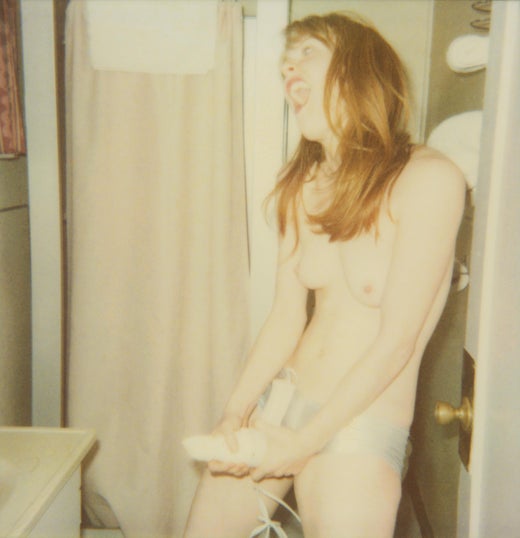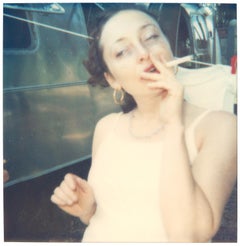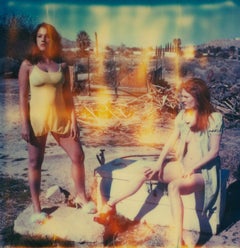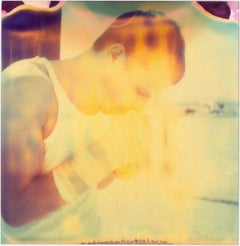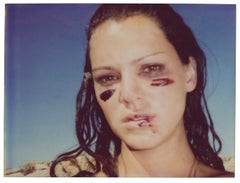Want more images or videos?
Request additional images or videos from the seller
1 of 11
Stefanie SchneiderDaisy and Austen in front of Trailer - based on a Polaroid Original - Proof2005
2005
$980List Price
About the Item
- Creator:Stefanie Schneider (1968, German)
- Creation Year:2005
- Dimensions:Height: 49.22 in (125 cm)Width: 48.43 in (123 cm)Depth: 0.04 in (1 mm)
- Medium:
- Movement & Style:
- Period:
- Condition:
- Gallery Location:Morongo Valley, CA
- Reference Number:1stDibs: LU652316220522
Stefanie Schneider
Stefanie Schneider received her MFA in Communication Design at the Folkwang Schule Essen, Germany. Her work has been shown at the Museum for Photography, Braunschweig, Museum für Kommunikation, Berlin, the Institut für Neue Medien, Frankfurt, the Nassauischer Kunstverein, Wiesbaden, Kunstverein Bielefeld, Museum für Moderne Kunst Passau, Les Rencontres d'Arles, Foto -Triennale Esslingen., Bombay Beach Biennale 2018, 2019.
About the Seller
4.9
Platinum Seller
Premium sellers with a 4.7+ rating and 24-hour response times
Established in 1996
1stDibs seller since 2017
1,050 sales on 1stDibs
Typical response time: 1 hour
Authenticity Guarantee
In the unlikely event there’s an issue with an item’s authenticity, contact us within 1 year for a full refund. DetailsMoney-Back Guarantee
If your item is not as described, is damaged in transit, or does not arrive, contact us within 7 days for a full refund. Details24-Hour Cancellation
You have a 24-hour grace period in which to reconsider your purchase, with no questions asked.Vetted Professional Sellers
Our world-class sellers must adhere to strict standards for service and quality, maintaining the integrity of our listings.Price-Match Guarantee
If you find that a seller listed the same item for a lower price elsewhere, we’ll match it.Trusted Global Delivery
Our best-in-class carrier network provides specialized shipping options worldwide, including custom delivery.You May Also Like
Elena Seated
By Jack Perno
Located in Chicago, IL
Archival Pigment Print
Edition of 25
Print size: 38 H x 30 W inches
Frame size: 54 H x 44 W inches
This piece is a digital reproduction of an original 8 x 10" polaroid that was man...
Category
21st Century and Contemporary Contemporary Color Photography
Materials
Archival Ink, Archival Paper, Inkjet, Polaroid
Elena Washing
By Jack Perno
Located in Chicago, IL
Archival Pigment Print
Edition of 25
Print size: 38 H x 30 W inches
Frame size: 54 H x 44 W inches
This piece is a digital reproduction of an original 8 x 10" polaroid that was man...
Category
21st Century and Contemporary Contemporary Color Photography
Materials
Archival Ink, Archival Paper, Inkjet, Polaroid
Ferrari tire change by Tyler Shields - Framed Photograph
By Tyler Shields
Located in New York City, NY
Los Angeles-based photographer Tyler Shields seeks “beauty in chaos,” capturing both young models and celebrities such as Lindsay Lohan and Mischa Barton. His polished editorial imag...
Category
2010s Contemporary Color Photography
Materials
Plexiglass, Archival Paper, C Print
Price Upon Request
H 36 in W 46 in D 2 in
Champagne by Tyler Shielsd
By Tyler Shields
Located in New York City, NY
Los Angeles-based photographer Tyler Shields seeks “beauty in chaos,” capturing both young models and celebrities such as Lindsay Lohan and Mischa Barton. His polished editorial imag...
Category
2010s Contemporary Color Photography
Materials
Plexiglass, Archival Paper, C Print
PILL BOX by Tyler Shielsd (70x70in) PROVOCATEUR series
By Tyler Shields
Located in New York City, NY
Los Angeles-based photographer Tyler Shields seeks “beauty in chaos,” capturing both young models and celebrities such as Lindsay Lohan and Mischa Barton. His polished editorial imag...
Category
2010s Contemporary Color Photography
Materials
Plexiglass, Archival Paper, C Print
Price Upon Request
H 70 in W 70 in D 0.1 in
PILL BOX by Tyler Shielsd (30x30in) PROVOCATEUR series
By Tyler Shields
Located in New York City, NY
Los Angeles-based photographer Tyler Shields seeks “beauty in chaos,” capturing both young models and celebrities such as Lindsay Lohan and Mischa Barton. His polished editorial imag...
Category
2010s Contemporary Color Photography
Materials
Plexiglass, Archival Paper, C Print
Price Upon Request
H 30 in W 30 in D 0.1 in
PILL BOX by Tyler Shielsd (60x60in) PROVOCATEUR series
By Tyler Shields
Located in New York City, NY
Los Angeles-based photographer Tyler Shields seeks “beauty in chaos,” capturing both young models and celebrities such as Lindsay Lohan and Mischa Barton. His polished editorial imag...
Category
2010s Contemporary Color Photography
Materials
Plexiglass, Archival Paper, C Print
Price Upon Request
H 60 in W 60 in D 0.1 in
PILL BOX by Tyler Shielsd (45x45in) PROVOCATEUR series
By Tyler Shields
Located in New York City, NY
Los Angeles-based photographer Tyler Shields seeks “beauty in chaos,” capturing both young models and celebrities such as Lindsay Lohan and Mischa Barton. His polished editorial imag...
Category
2010s Contemporary Color Photography
Materials
Plexiglass, Archival Paper, C Print
Price Upon Request
H 45 in W 45 in D 0.1 in
BIRKIN SPLIT by Tyler Shielsd (18x18in) INDULGENCE series
By Tyler Shields
Located in New York City, NY
Los Angeles-based photographer Tyler Shields seeks “beauty in chaos,” capturing both young models and celebrities such as Lindsay Lohan and Mischa Barton. His polished editorial imag...
Category
2010s Contemporary Color Photography
Materials
Plexiglass, Archival Paper, C Print
Price Upon Request
H 18 in W 18 in D 0.1 in
PRADA BUBBLEGUM by Tyler Shielsd (18x18in) INDULGENCE series
By Tyler Shields
Located in New York City, NY
Los Angeles-based photographer Tyler Shields seeks “beauty in chaos,” capturing both young models and celebrities such as Lindsay Lohan and Mischa Barton. His polished editorial imag...
Category
2010s Contemporary Color Photography
Materials
Plexiglass, Archival Paper, C Print
Price Upon Request
H 18 in W 18 in D 0.1 in
More From This Seller
View AllUntitled (Cathy and Shannon) - Contemporary, 21st Century, Polaroid
By Stefanie Schneider
Located in Morongo Valley, CA
Untitled (Cathy and Shannon) - 2004
20x20cm, Edition of 10, plus 2 Artist Proofs.
Archival C-Print, based on a Polaroid.
Certificate and Signature label.
Artist Inventory No. 480...
Category
Early 2000s Contemporary Color Photography
Materials
Archival Paper, Photographic Paper, C Print, Color, Polaroid
The Games we played (Till Death do us Part) - Contemporary, Polaroid, Women
By Stefanie Schneider
Located in Morongo Valley, CA
The Games we played (Till Death do us Part) - 2005
20x20cm,
Edition of 10, plus 2 artist proofs.
Archival C-Print print, based on a Polaroid.
Certificate and Signature label, art...
Category
Early 2000s Contemporary Color Photography
Materials
Archival Paper, Photographic Paper, C Print, Color, Polaroid
Untitled (Traintracks) - based on a Polaroid
By Stefanie Schneider
Located in Morongo Valley, CA
Untitled (Traintracks) - The Last Picture Show - 2004
50x50cm.
Edition of 5, and 2 Artist Proofs.
Archival C-Print, based on the Polaroid.
Signature label and Certificate.
Artis...
Category
Early 2000s Contemporary Portrait Photography
Materials
Archival Paper, Photographic Paper, C Print, Color, Polaroid
'Penelope' from the movie Immaculate Springs - starring Jacinda Barrett
By Stefanie Schneider
Located in Morongo Valley, CA
'Penelope' from the movie Immaculate Springs - 1998
Edition of 10,
20x30cm, plus 2 Artist Proofs.
Archival C-Print, based on the Polaroid.
Signature Label and Certificate.
Artis...
Category
1990s Contemporary Portrait Photography
Materials
Archival Paper, Photographic Paper, C Print, Color, Polaroid
Untitled (Olancha) - Stranger than Paradise - analog C-Print based on a Polaroid
By Stefanie Schneider
Located in Morongo Valley, CA
Untitled (Olancha) - 2006
38x37cm.
Edition of 5, plus 2 Artist Proofs.
Analog C-Print, hand-printed by the artist, based on a Polaroid.
Signature label and Certificate.
Artist I...
Category
Early 2000s Contemporary Portrait Photography
Materials
Archival Paper, Photographic Paper, C Print, Color, Polaroid
I will be just fine (Memories of Green)
By Stefanie Schneider
Located in Morongo Valley, CA
I will be just fine (Memories of Green) - 2003
Edition of 5,
58x56cm,
analog C-Print, hand-printed by the artist on Fuji Crystal Archive Paper,
based on a Polaroid, Artist inventor...
Category
Early 2000s Contemporary Color Photography
Materials
Archival Paper, Photographic Paper, C Print, Color, Polaroid
